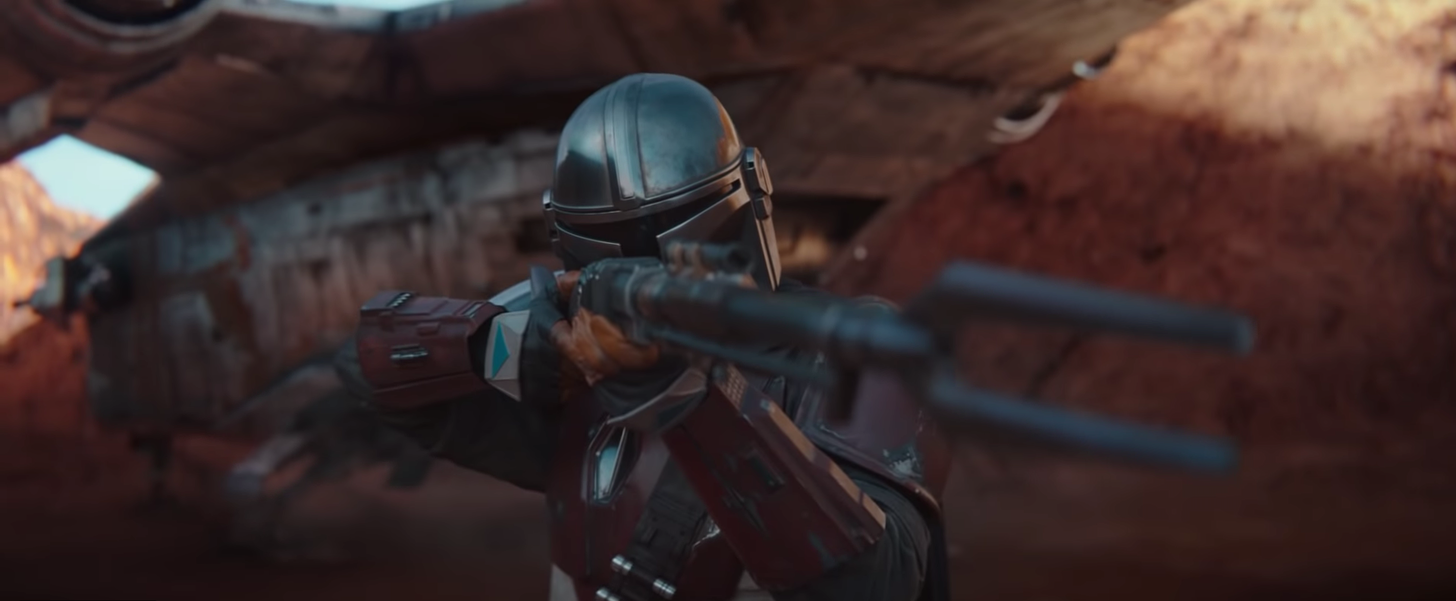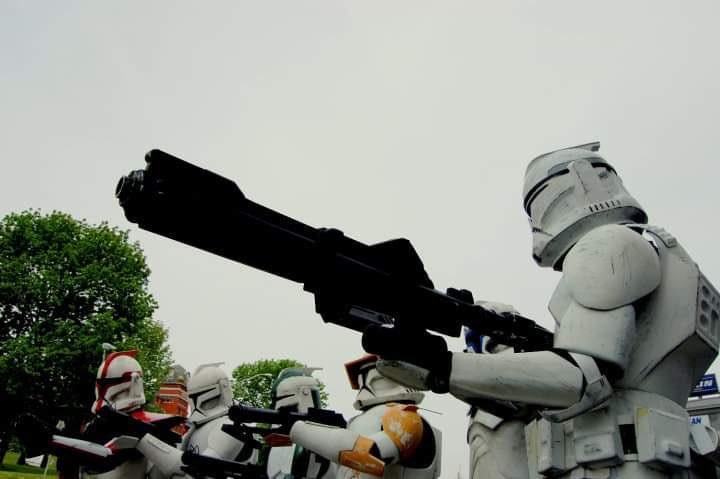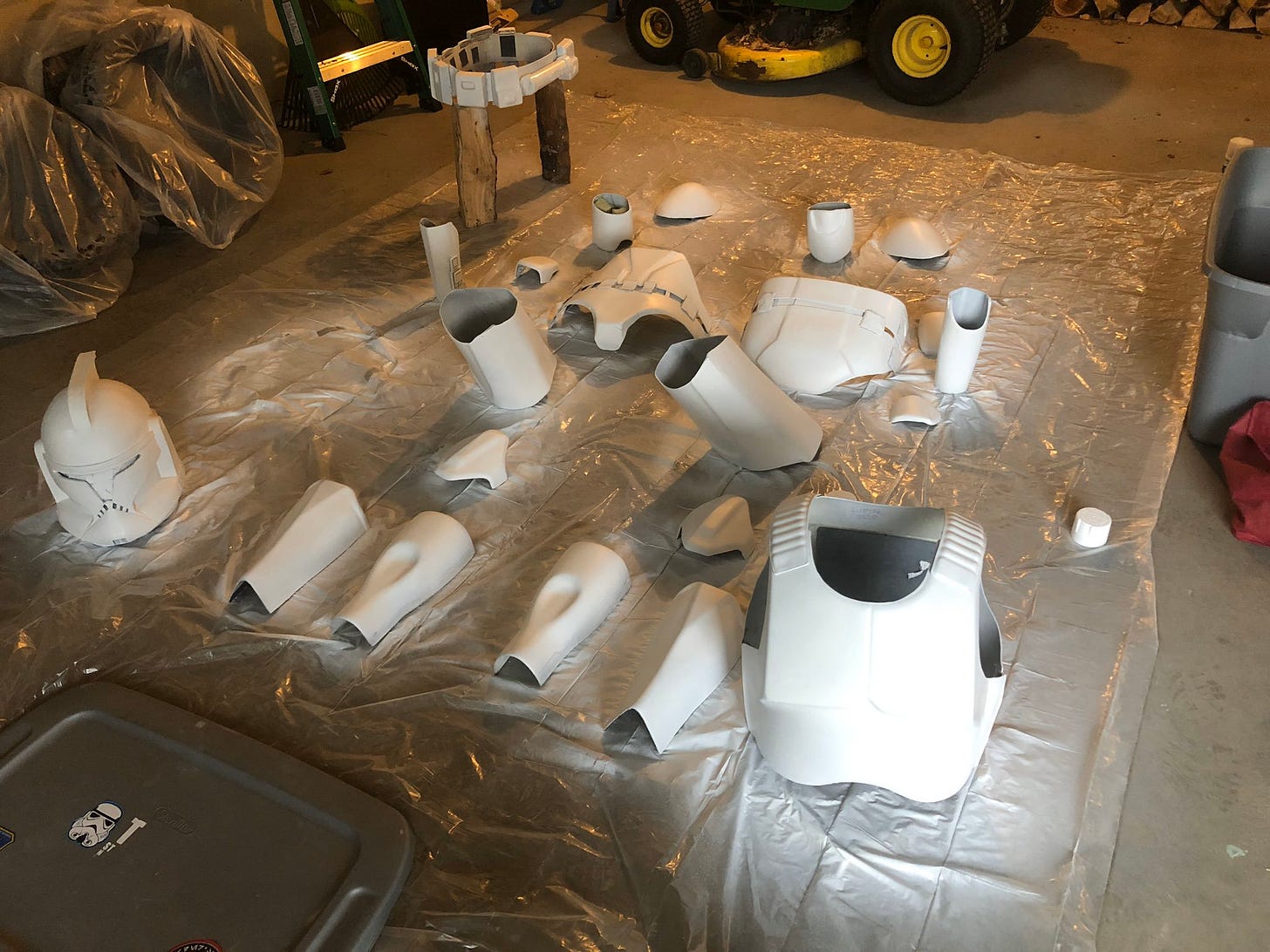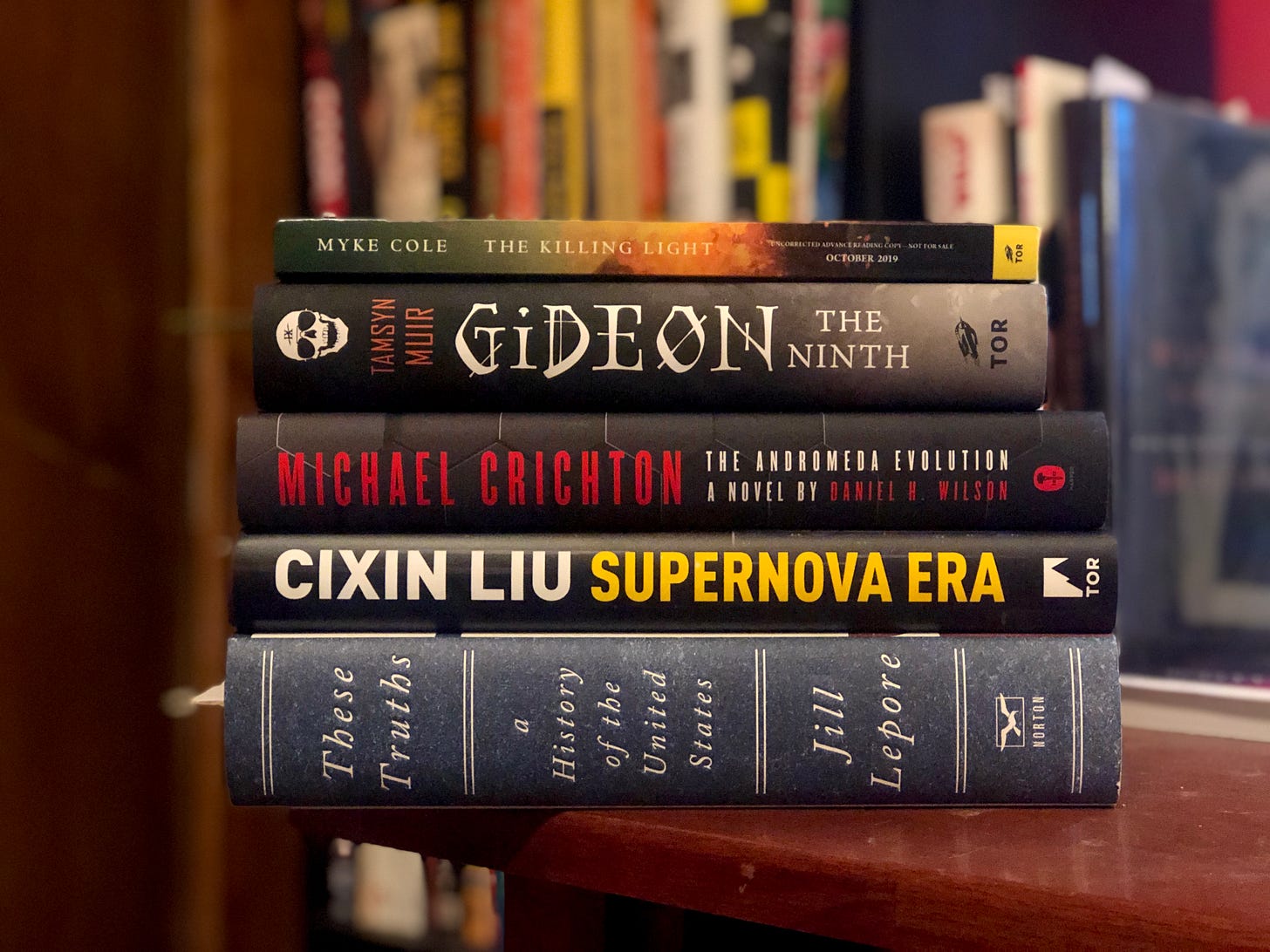Mandos, clones, and bad publishers


Hello!
It’s been a busy couple of weeks, between teaching and regular writing work. And, yesterday was Disney + day! It’s extremely exciting because it meant the release of The Mandalorian, which I’ve been really pumped for. Some thoughts ahead, as well as an overview of some costuming work, and more.
The Mandalorian, S1E01
Just a word of warning — I’m gonna be talking about the first episode of The Mandalorian, and there’ll be some spoilers. There’s no way to black out the text to make it spoiler-friendly, so if you haven’t seen the episode and don’t want to be spoiled, jump down to the next section.
A long-unfulfilled dream within the Star Wars universe has finally come into being. With the debut of Disney +, Lucasfilm released the first-ever live-action Star Wars television series, The Mandalorian. Set a couple of years after the fall of the Empire in Return of the Jedi, this series is about a lone Mandalorian bounty hunter who’s trying to make his way in life in the galaxy’s outer rim, and accepts a bounty from a mysterious benefactor, who sends him off onto a distant planet.
Seriously, spoilers from here on out. Scroll down if you want to avoid it.
This first episode does all that a pilot needs to do: introduce the character, the world, and the situation. The episode opens with the bounty hunter on the job — he takes out a group of thugs at a seedy underworld bar, delivers them to his handler, and is sent off to take on a mysterious contract.
This individual seems to be someone linked to the Empire — he has a squad of Stormtroopers at his disposal, and has some highly sought after hard currency on hand. He sends the Mandalorian off on a retrieval mission, but lets him know that if he can’t retrieve his target, he can bring back proof of death for a slightly lower rate. The Mandalorian heads off to the planet in question, learns how to ride one of the native lifeforms, and gets into an intense firefight, only to discover that his target isn’t what he thought it was. (Okay, if you’ve seen the episode and want to nerd out about it, email me, because what?!)
A couple of things stood out for me about this episode. It was well-paced, felt extremely Star Wars, and it’s a good example of the bifurcated storytelling of the franchise.
First up, Star Wars has existed in the television world for more than a decade now — The Clone Wars, Rebels, and Resistance have all shown that you can spin out a long-form story, and develop longer stories and deeper characters than the films. The trick with The Mandalorian is that it’s taking that to the adult range of fans, rather than the presumably younger audience that the animated shows are aimed at. I’ve long felt that the animated shows not only told some of the most interesting stories of the franchise, but also that it was one of the things that secured its future with incoming generations. Kids aren’t as interested in a film from the 1970s/1980s. You’ve got a whole new group of fans who came of age watching those animated series, and for them, that’s their Star Wars.
A streaming series is a bit of a necessity in the streaming age that we’re in now, and it has to cater not only to fans who expect certain tropes, but who’re also expecting those tropes to work alongside the long form stylings of serialized television. It’s hard to tell how The Mandalorian will do until we see the entire series, but so far, it looks good. The pilot introduced plenty of nods to backstory and contextual events, interesting characters, and some solid motivation on the part of the characters.
The Star Wars tropes are generally pretty easy to replicate in any format. Lucasfilm doesn’t throw anything out: they endlessly recycle designs, and the world is ripe for dropping in familiar things. R2 unit? Yep. Stormtroopers? Got them. Carbon freezing? Brr. Nods to more obscure things like the Star Wars Holiday Special? They’re everywhere. Easter eggs are easy to do, and the show does it reverently.
This first episode also shows off a bit of the grittier side of Star Wars. It seems like there’s two types of stories you can tell here: one is the more heroic, straight-up adventure story that’s bombastic and plenty of fun (the Skywalker Saga films), while the other digs into the dirt and grime of the used-universe. Books like the X-Wing or Republic Commando series fit into that model, as does the two standalone films, Rogue One and Solo. You also have weird books like Matt Stover’s Shatterpoint or Luke Skywalker and the Shadows of Mindor, which are kind of in a category of their own. Personally, I like the harder, grittier take on the world, because it feels a bit more true to the universe that we saw in 1977. That said, given some of the revelations from the first episode, I’ll be interested to see if that changes.
What most impressed me so far is how the series is filling the role that the standalone films have played thus far: telling random stories that don’t fall into the main saga backbone. There’s a twist on this, too: this series doesn’t really appear to be a space-filler, designed to fill some random plot point. Rogue One explained how the Death Star plans fell into Rebel hands, and why it had a weak point. Solo explained the Kessel run. They were good films, but didn’t necessarily advance the larger story in any meaningful way, at least in a way that we didn’t already know the outcome here. In this case, I’m really intrigued at where this could go. We know some eventualities, but the film is so far removed from the main saga that there’s surprise at play. We’ll see how that turns out.
Next episode drops on Friday — I already can’t wait.

Okay, spoilers over! You can safely read again.
Cloning Around
I got some good news the other day. I can’t share what it is precisely yet, other than that it’s a really cool 501st troop, something I’ve never done before. I’m wearing my Attack of the Clones Clone Trooper to it, and when I pulled it out of the box for a quick look over, I realized that it’s pretty battered, and it needed a bit of an overhaul.
I finished up the costume in August 2009, after about a year’s worth of work. I’d been thinking about building the costume for the theatrical release of The Clone Wars, which debuted in theaters in August 2008, and it was a project that really changed how I thought about costuming. My original stormtrooper was something that I was easily able to assemble out of the box — slap on the included velcro and go. I did it in about a day. Building the clone forced me to learn a bunch of new things: how to properly assemble a costume, using glue, bondo, and paint. I debuted it at a couple of troops, but memorably during the Boston St. Patrick’s Day Parade.

I always really liked the look of the Clones when I first saw them in Attack of the Clones. They were the highlight in the film, and stories like The Clone Wars TV show and Karen Traviss’s fantastic Republic Commando stories only deepened their story. They look damn cool — and that they’d seen plenty of action in their world. When I constructed mine, I made sure to beat up the armor, putting on plenty of scratches on the high points — something that always elicited interest from people I encountered.

A decade’s worth of troops has taken its toll. High-impact polystyrene cracks with time and pressure, and the edges of various parts have done just that. The paint wore down to the plastic in places, and I no longer have the body of a 23-year-old. Years of grime and use and abuse covered the suit. It looked battered, but not in the way that I wanted. I’ve wanted to make upgrades to it — I’ve had a more accurate backplate that I’ve wanted to install, minor fixes in other places — but I’ve always been reluctant to do anything, because it would require a repaint, which would make the armor look a bit odd. But the paint was already pretty worn, and even yellowish in places.

So, this news was the kick I needed: I thought about it for an hour, and realized that it had to be done. So, with two days of 50 degree weather left, I primed the entire thing, covering up a decade’s worth of scratches and dings and memories. I glued patches under the cracks, tore out things that needed replacing, and ran down the list of long-deferred maintenance. When the snow came, I borrowed a friend’s garage to give it a nice, new coat of matte white paint. I took a piece of sandpaper to redo the scratches and dings that made it so distinctive, and then sprayed on a clear coat to lock it in.

I wanted to go a bit further with the used look, though. The scratches always looked good for it, but after working on my Shoretrooper, I realized that I needed to do more with it. I took a mixture of black and gray paint, and set about adding on some grime to the surface. My physical approach has always been to make the weathering look natural, like I’d been in the field and tried to clean off the dust and dirt. Scratches, nooks and crannies retain dirt, while the higher points are a bit cleaner. My garrison-mate Brian Anderson put together a really good tutorial a couple of years ago, as did Adam Savage.
Weathering is a story in and of itself: it tells you something about the character, where they’ve been, and what they’ve done. It gives presence to the character. I focused on making sure that the shins and lower thighs were hit the hardest, while the upper parts of the armor were a bit cleaner. The cheeks on the helmet get a bit more under the edge, which gives the helmet a bit more definition. By the time I was done and threw it all on, I was staggered at how well it came out. I still have some minor tweaks to do — the grime on the boots are a bit redish, the abs needs to be tucked in better, I’m getting a new belt and undersuit, and a friend printed me a set of macrobinoculars to carry around in place of a gun, etc. — but I’m really pleased with how well this came out. I can’t wait to troop in it. (If you’re in Vermont this weekend, I’ll be bringing it to the UVM Hockey Game. Find me, and I’ll give you something.)

Troubles With ChiZine
Horror publishing erupted into a bit of a fury in the last week. A number of authors began to speak about issues that they had with getting royalties and systemic harassment with a small Canadian publisher called ChiZine. It’s a bit of a surprise, because ChiZine has been pretty well acclaimed — they’ve published a number of good books, and I’ve had friends sign with them.
The word started to break last week when a bunch of authors started to complain about the press, and High Fever Books, a review site / publishing imprint, wrote to say that they’d no longer review books from the publisher. It snowballed from there, with a ton of authors sharing their stories of harassment and that they were pulling their works from the publisher. A good friend of mine pulled his book from their list, and got back the rights to his other one with them.
ChiZine published a response about one of the payment issues, but denied that they had attempted to blacklist or harass the author in question. Yesterday, it announced that Sandra Kasuri and Brett Savory, the people behind ChiZine, would step down immediately, and that Christie Harkin would take over to ensure that all of the logistical details were taken care of.
It’s a pretty stunning fall, and it comes right after Fireside Fiction abruptly terminated a bunch of contracts for a handful of novellas. Both instances highlight a noteworthy thing in the publishing world: small presses and publications are often run by people who are passionate about what they’re doing, but find that doing everything themselves is overwhelming, and that the people who work there set the tone for their operations and environment. Fireside messed up, but it seems (at least from what I’ve seen) to be due to Pablo Defendini biting off more than he can chew.
ChiZine’s case seems to be more troublesome, based on the accounts of people who have worked there. Employees — who all seem to have been unpaid — pointed to systemic harassment and toxic behavior from Kasuri and Savory. They’ve been accused of abusing their authors, pushed their employees to harmful levels of stress, and creating a bad work environment.
It’s an example of where organizations develop some extremely bad practices about their employees. I’ve endured some of this over the years — micromanagement, unreasonable work loads, etc. — and it really has its toll. ChiZine isn’t alone here — I’ve heard some stories from other imprints in recent months as well. While ChiZine has its defenders, the question that I’d always ask in these situations is: how many talented people get burned out of an industry because of these practices? And is the output of a handful of good books really worth that? I think the answer is pretty obvious.
Further Reading
- Alternate Space Races. I reviewed For All Mankind the other week, and over on the Barnes & Noble’s Sci-Fi and Fantasy Blog, I put together an overview of the various times that science fiction has reimagined the space race. I was surprised at this result: there have been only a handful of novels. I wouldn’t be surprised if there are some other short stories that aren’t widely known/available.
- Automated Factories. The New York Times has another installment from its Op-Ed From the Future series, this time from Brian Merchant, who wrote the fantastic book The One Device: The Secret History of the iPhone, and who recently ran Terraform at Vice Motherboard. This is a fantastic little story about the automation of work, and the impact that it has on workers. It’s written from the perspective of a third-party contractor that services one of Amazon’s “human-free” distribution centers, and it’s yet another story that’s chillingly relevant to 2019. That tracks nicely with The One Device, which looked at not only how Apple developed the iPhone, but what the cost was, on miners who extract the materials that make them, to the workers who put up service towers for AT&T and Verizon.
- His Dark Materials. Over on the Barnes & Noble Sci-Fi and Fantasy Blog, I’ve written up a history of Philip Pullman’s His Dark Materials series, just in time for the new HBO show. (Which I’m really enjoying)
Simplicity of books. Craig Mod has a great essay about the staying power of books in a digital world, Stab a Book, the Book Won’t Die. He explores the relationship between a reader and a physical book, and it’s an argument that goes far beyond the deplorable “I just love the smell of a physical book” argument that gets floated whenever someone cranks about the value of reading.
Mod argues that physical, printed mediums have a clear “contract” with the reader: you know exactly what you’re getting from it, whereas with digital publications will have extra, distractible features. As someone who struggles with attention, it’s an argument that I really appreciate.
We buy a book, we know what we’re getting. There is no other “business model” at play. No other information being (necessarily, relatively) sold. This clarity of contract is especially lucid in physical form. The book has edges. The transaction has edges. The transaction completes. Given time, we complete the book. It has an ending. Contracts are clear. Usually, there’s no tracking.
- Wolfe moves to Subterranean. In my last letter, I noted that Saga editor Navah Wolfe had been fired. Fortunately, she’s found a new home quickly: Subterranean Press, which produces a number of really fantastic books. She’ll be acquiring and novellas to be released in 2021. That’s pretty exciting news, and I wonder what it means for Subterranean: they seem to serve a pretty niche audience, and I wonder if they’re looking to expand a bit. If they do, that’s a really good thing for the genre community.
Currently Reading

I feel like I’ve been behind in my reading the last couple of weeks. I finished Philip Pullman’s The Secret Commonwealth, and have some thoughts on that that I’m trying to gel into a review. In the meantime, I’ve been working my way through Jill Lepore’s phenomenal book These Truths: A History of the United States. It’s a daunting read, one that covers the entirety of US history, looking at it through a lens of racial discrimination, slavery, and oppression. It’s eye-opening and is proving to be an essential read, especially in this day and age, when people seem to be unaware of the complexity of the American story.
I’ve also picked up Daniel H. Wilson’s The Andromeda Evolution, based on Michael Crichton’s novel The Andromeda Strain, which is exciting so far. I’ve also got Cixin Liu’s Supernova Era, Tamsyn Muir’s Gideon the Ninth, and Myke Cole’s The Killing Light, all of which I’m enjoying, although I’m not terribly far in any just yet.
After that, I’ve got a usual stack. Fortunately, with the end of the year coming, there isn’t much left to pick up, and while there are books I’m excited for in 2020, It’s looking like I can take a little bit of time to catch up.
End of the Year / Decade
We’re coming up on the traditional retrospective time for the year and decade. I’m planning on putting together two lists: the best books of the year, as well as the best books of the decade. (Maybe some other sort of roundup of the biggest nerd things of 2019 / 2010-2019). I’ve got running lists going of all those things, but I’d be really interested in hearing what your candidates might be for, well, any of them.
That’s all for now. Thanks as always for reading — let me know what you’ve been reading/writing/thinking!
Andrew